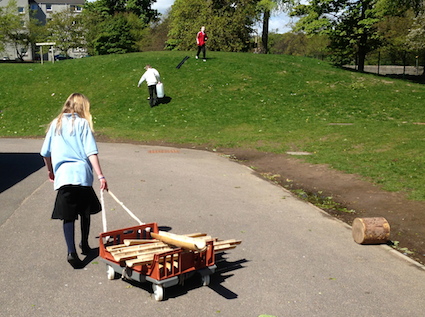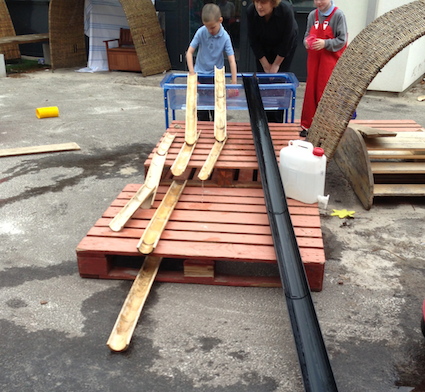
Several years ago I bought a set of bamboo guttering comprising of 6 short and 6 long lengths. I’ve used it so many times, with so many classes and groups and in so many ways. Here’s some of the reasons why it is such a useful resource…
1. It is light and easy to carry about
If you have to take resources in and out or, like me, were in a job which involved moving from class to class, you will find the bamboo very portable. Shopping bags on wheels are great for those who need to move it inside and out daily. Here it is being carried on a bread crate dolly:

2. It is suitable for all ages, stages and abilities
Even adults like experimenting and playing with it on my courses. The guttering is narrower than your traditional plastic guttering so can squeeze through fences and into pallets more easily.

3. It can be used in a tiny space
The guttering works well in miniature play zones. Here’s an example of a water wall created on a gate. This matters if you are short of space. Really strong velcro works a treat for attaching the guttering to a range of places.

4. Challenges naturally present themselves
This group of 10-12year olds were fascinated by the challenge of making the longest guttering run possible which spilled the least amount of water. I find group work and cooperative play happens without it being organised by the teacher.

5. Children find themselves creating their own investigations
Here, comparing the natural and plastic guttering proved irresistible to this group of 6yr olds. You can see that the differences between types of guttering add to the play value.

6. The fun doesn’t begin and end with water
Guttering + a pile of bark chips = lots of experiments. Check out the potential of burying animal tubes as part of the run. A similar situation can happen with gravel piles or lots of sand.

7. Bamboo is environmentally friendly product
- Bamboo is a top renewable resource. It is able to double or even triple its mass in one growing season, requiring little more than water, soil, and sunlight.
- Bamboo is highly efficient in converting carbon dioxide into oxygen, and may be used to help curb the effects of global warming.
- The product is strong, some have greater density than oak, yet are light weight and flexible,
- The new shoots that emerge every spring are edible and can be managed as a food crop, yielding many pounds of fresh produce each spring.
- Toys are starting to be made of it, play material for dens as well as the ever present garden material it is more commonly known for.
- The pulp can be made into paper, culms into timber, Innovative architects are designing earthquake resistant houses, using bamboo as the primary structure,
- it is used in high rise construction as scaffolding.
- Remember to start looking for bamboo that is sourced locally – or even grow your own.
8. Caring for bamboo products (advice from Cosy)
Like all natural products, it requires a little more looking after than man-made resources, but the multi-sensory and rustic feel adds value and is worth the effort.
Be bamboo aware – check upon arrival:
- Some peeling of the inner skin is normal.
- There will be trace amounts of mildew as this is inherent in the product. Very occasionally fungi will bloom – see below for treatment.
- Your product may arrive with cracks in the stems. This is normal. Please let the supplier know if they arrive with full splits that cut all the way through the bamboo. This would be a damaged item.
- The insides at each node have a skin known as a diaphragm or membrane. Check that these are intact. These are more fragile than the stems and occasionally have holes. This is not a fault, it’s how bamboo grows. As the diaphragms are naturally weak, do not expect the supplier to replace items with broken diaphragms once used. See the extension ideas below for ways of making bamboo as safe as necessary when this happens.
- Bamboo is a natural product and changes in response to temperature and humidity in the environment. As a result, you need to check for splinters which may have emerged prior to using with children. Sand these down.
- A variety of markings, colourations and stains from growing, processing and transit is normal and part of the rustic charm of bamboo.
Care needs
- Most bamboo products can be used outside or in.
- Always dry thoroughly before storing in shed or similar overnight.
- Ensure air can circulate around product when stored.
- Treat with love and care – avoid dropping it, stepping on it and other rough treatment.
- Check regularly for splinters and splits. Pull off carefully and/or sand down.
- Keep edges sanded down.
- Teach the children how to look after the bamboo and what to do when they find a split, splinter or other concern. This can be part of your overall approach to risk benefit assessments and trusting children to develop the responsibility and awareness needed to use products which are not toys – an essential life skill.
Extension ideas to extend the shelf life of the resource
- Cover both sides of any splits that occur with duct tape, or similar.
- A broken diaphragm can be removed by carefully chipping away the remainder of the diaphragm. Sand down thoroughly to make smooth. Children enjoy using the hollow tubes as a loose part in their own right.
Cleaning bamboo and managing the mould and fungi
Mould is essentially caused by moisture. Clean and dry promptly at the end of each day to counter mould from growing.
If you do find a sudden growth of fungi or mould, then brush off mould in a well-ventilated area, preferably outdoors, using a brush with decent bristles. Remember to wear protective gear in line with your establishment’s cleaning policy and procedures.
For a deeper clean, try one of the following:
- Using bicarbonate of soda, either in a paste using warm water, or by itself and scrubbing the bamboo with this. This works especially well on all porous surfaces. Allow the sodium bicarbonate to penetrate the damp surface and then wipe away. Sodium bicarbonate is renowned as a gentle household cleaner and helps deodorize.
- On a warm damp, non-abrasive cloth, add some salt and rub into the exterior of the bamboo to remove stains. Polish with a dry soft cloth.
- Using a mix of one part vinegar to twenty parts water to scrub the bamboo.
Remember to allow the bamboo to dry thoroughly before storing.
Finally…
Bamboo is in this basic state needs to be considered as a loose part but not a toy. This means it needs to be supervised when used with children by a competent professional early year’s educator or teacher.
This post was first published in March 2014




















Yes I did the same but my children got splinters from it!! Parents said it reminded them of Japanese torture, growing bamboo under the skin!!
How do you avoid that problem?
Hi Shona
I’m sorry to hear this. I’ve had splinters from using the thin bamboo cane but not from the bigger guttering which Cosy appear to have sanded down very well.
I’ve come across cracked pieces of bamboo – mostly for me this has been with trial material. In this instance I cover with duck tape – not especially natural looking but it covers ragged endings nicely. This may be an option for your setting.
Best wishes
Juliet
Bamboo guttering is a new one for me, must try and source some locally – much nicer than plastic.
Such a natural look and as you say a resource with so many creative uses – some which the children create that you would never thought of too! Thanks for linking up and sharing their fun with Country Kids.
I love my bamboo guttering too & as you say it is so light, having now seen those blue twisty ties in person, I need them now!
I’ve seen guttering used in a few kids outdoor project ideas, particularly on pinterest. My husband works with guttering so we are able to get our hands on a lot of it! I like the idea of bamboo guttering, I think I’ll have to incorporate it into an outdoor activity this summer with my kids.
Thanks Danielle – Love your website too! It really is all about pipe dreams 🙂